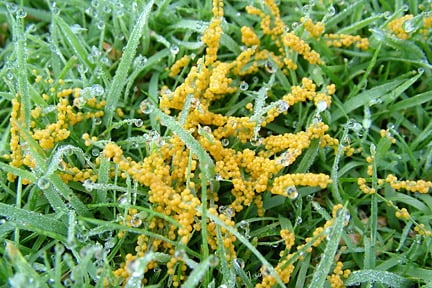
Quick facts
Common name - Slime moulds
Scientific name - Physarum cinereum, Mucilago crustacea and Fuligo septica
Plants affected - Turf grasses
Main symptoms - Slimy growths on lawns
Caused by - Slime moulds
What are slime moulds?
A slime mould is a primitive organism, sharing some similarities with both fungi and single-celled animals. The spore-producing structures of slime moulds can appear on lawns quite suddenly, sometimes overnight. No control is usually required, and the structures soon disintegrate to release a mass of spores. Slime moulds may be found throughout the year, but are most common in late summer and autumn.
The most common slime moulds on lawns are Physarum cinereum, Mucilago crustacea and Fuligo septica.
Symptoms
These are very variable and dependent on the species of slime mould. Those seen most commonly on lawns or other grassy areas include:
- Physarum cinereum: Clusters of grey-black pin-heads covering grass blades
- Mucilago crustacea: Irregular, crumbly yellow-white masses
- Fuligo septica: Irregular yellowish cushions (this has the common name of dog vomit fungus)
The structures of Mucilago and Fuligo are commonly 2-4cm (¾-1½in) in diameter, but Fuligo can sometimes be considerably larger. All of these species produce masses of tiny, black spores as their fruiting structures disintegrate.
Control
No control is required as the slime mould is simply using the grass as a support on which to produce its fruiting structures. These will often vanish as quickly as they have appeared. If they are particularly unsightly they can be dispersed with a jet of water.
Biology
Slime moulds do not attack plants, but obtain their food by engulfing bacteria, fungal spores and other tiny pieces of organic material as they move. Some slime moulds spend most of their life as single-celled, amoeba-like structures, invisible to the naked eye. Others form a larger structure called a plasmodium. The plasmodium constantly changes its shape as it creeps along, and is sometimes seen as a white or yellow (but sometimes other colours) slimy ‘sheet’, or a network of strands, on the soil, grass, or stems and lower branches of plants.
Slime moulds are triggered into spore production by environmental conditions. Depletion of is a common trigger. The spore-producing structures may develop throughout the year, but are found most commonly in late summer and autumn. The spores of many slime moulds are extremely resilient and can survive for many years before .








